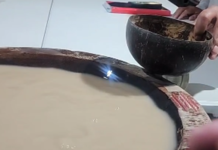Tonga’s largest ancient royal tombs, the ‘Otu Langi at Lapaha, have been proposed as a UNESCO World Heritage Site.
If UNESCO agrees to list the site it will provide funds for restoration, preservation and training.
The proposal was announced at a workshop in Lapaha on October 7.
If the tombs secure World Heritage status, they will join the likes of the Tombs of Buganda Kings at Kasubi in Uganda and the Royal Tombs of the Joseon Dynasty in South Korea as sites of outstanding value to the world.
UNESCO placed ‘Otu Langi on a World Heritage tentative list on August 9, 2007 after Tonga provided its “authenticity of claims” with evidence about the royal tombs from the Tongan Traditions Committee.
The evidence includes information about the writing of the Kings in the early European contact period, the continuing traditions and care of the tombs and details of who is buried.
Knowledge about the tombs is vested in local families at Lapaha.
According to the evidence submitted to UNESCO, the langis are platforms of earth with a stepped pyramid effect supported by stone slabs as surrounding walls.
“It is said that the construction of these massive tombs was a way to demonstrate the spiritual and political power of the Tu’i Tonga,” the report said.
“These tombs and the rituals that surround the burial of the descendants of the Tu’i Tongas in the same tombs are still a living part of the Tongan culture to this present day.
“It is believed also that Tu’i Tongas constructed these tombs as a symbol of their respect for the Heavenly Fathers that became Kings of Tonga.”
The three-day workshop was run to give stakeholders and the people of Lapaha information about how the World Heritage Site programme works and what would happen if the submission is approved.
Benefits
People attending the workshop were told the kingdom would benefit if UNESCO agreed to list the site.
It would provide funds for restoration, preservation and training and promote awareness about the need to preserve the site.
Listing the site would promote close ties with the United Nations system and the prestige and support this provided.
It would also provide access to global project management resource and help create partnerships between government, the private sector and NGOs working to conserve the site.
If the site is listed it will be protected under the Geneva Convention against destruction or misuse during wartime.
Ha’amonga ‘a Maui Historic Park
Tonga submitted the Ancient Royal Tombs of Lapaha for consideration by UNESCO under the title The Ancient Capitals of the Kingdom of Tonga.
The submission also includes the Ha’amonga ‘a Maui Historic Park.
It claims the Ha’amonga ‘a Maui has “an astronomical or sundial function, marking the point on the horizon where the sun rises at mid-year.”
However, UNESCO remains unconvinced. It said that while the claims were generally held to be true, the source of the story was unclear and might be an idea introduced in the early 20th century.
Tonga signed UNESCO’s 1972 Convention Concerning the Protection of the World Cultural and Natural Heritage on April 30, 2004.
The main points
- Tonga’s largest ancient royal tombs, the ‘Otu Langi at Lapaha, have been proposed as a UNESCO World Heritage Site.
- If UNESCO agrees to list the site it will fund restoration, preservation and training.
- The proposal was announced at a workshop in Nuku‘alofa today.
- If the tombs secure World Heritage status, they will join the likes of the Tombs of Buganda Kings at Kasubi in Africa and the Royal Tombs of the Joseon Dynasty in South Korea as sites of outstanding value to the world.
For more information







